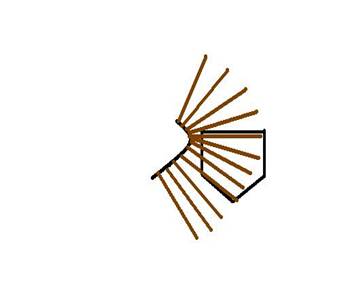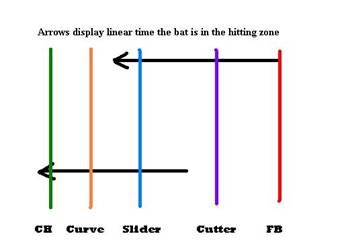PITCHING STRATEGY PART FOUR: THE MOST IMPORTANT SKILL IN TODAY’S GAME – PITCHING FRONT TO BACK
In order to understand the significance of pitching back to front in today’s game, it is important to first understand the evolution of hitting and what is being stressed today. To me, the biggest factor in changing hitting technique has been the advent of the aluminum bat.
When the aluminum bat first came out, many baseball people felt it would hurt hitters and they would have to learn to hit all over again once they started using heavier wood bats. The lighter aluminum bats allowed the hitters to wait longer before starting their swing, and they realized that by emphasizing bat speed through the hitting zone they could hit the ball out of any area of the park. Instead, three things happened to the skill of hitting:
- The players started using lighter wooden bats, and the bat manufacturers found ways to accommodate the players. Long gone are the days when it is macho to use a heavy bat. Hitters, being bigger and stronger than ever, can wait much longer to start their swing.
- Second, because the aluminum bats had a bigger sweet spot, it was harder for pitchers to jam hitters so they started to pitch more away and lost the skill of pitching in. In time, the hitters have migrated to stances much closer to the plate where they can cover the outer half of the plate easier. In addition, they now wear protective padding on their wrists, elbows and shins making them more comfortable against inside pitches. Even with pitchers now starting to throw more inside, the margin of error is much smaller than it used to be between an inside strike and hitting a player. Most hitters getting hit today are getting hit while starting their swing and not in trying to get out of the way of the ball. All of this has resulted in hitters shrinking the size of the plate because they can cover the outer half better, and they haven’t been seeing as many inside pitches.
- Hitting technique now really emphasizes staying inside the ball. Because the bats are lighter, hitters start their hands later and can whip the bat through the zone almost like it is a waffle ball bat. By keeping their hands inside and not casting them out, they keep the good part of the bat in the hitting zone longer. (See figure one.)
Figure 1. Bat Swing Path
 Good hitters today, by staying inside the ball, try to drive the fastball to the opposite field gap. By doing that they are able to keep many off-speed pitches fair and drive them to the power field.
Good hitters today, by staying inside the ball, try to drive the fastball to the opposite field gap. By doing that they are able to keep many off-speed pitches fair and drive them to the power field.
As a result of these hitting techniques, today hitters keep the good part of the bat in the hitting zone longer. Therefore, it is imperative that pitchers learn to pitch front to back with greater speed differential to get the hitters out of their rhythm.
Regardless of what a hitter does there is only so much time that the bat will stay in the hitting zone. Every hitter sets the back part of that timing to the fastest pitch that particular pitcher is throwing. Hitters that are trying to drive the fastball to the opposite field will keep the bat in the zone the longest.
Derek Jeter is a great example of this modern day philosophy that so many hitters are using today. He stands on top of the plate, looks for the ball middle to away, and tries to drive the fastball to the right center gap. He fights off inside pitches and isn’t afraid of getting jammed. He will only get out of this plan if a pitcher continually demonstrates to him that he can pitch him inside. Even then he will only turn on the ball to get the pitcher to start working him away again. By doing this his bat stays in the zone longer, and he is able to hit off-speed pitches up the middle and to left field. That being said, there is still only so much time the good part of the bat stays in the hitting zone.
Figure 2.
 Figure 2 shows the time the bat is in the hitting zone in a linear fashion. The top arrow shows how hitters set the back part of their zone to the fastball and then try to adjust to the other pitches.
Figure 2 shows the time the bat is in the hitting zone in a linear fashion. The top arrow shows how hitters set the back part of their zone to the fastball and then try to adjust to the other pitches.
Hitters adjust to the different pitches by waiting longer, early pitch identification, educated guesses, and the ability, even though their body has started, to keep their hands back.
The bottom arrow shows what happens if a pitcher throws enough pitches outside of a hitters linear time line. The hitter must adjust his timing to hit the slower pitches and therefore moves his whole time line to the place where he no longer can hit the fastball or keep it fair.
Pitchers today must make the hitters change the timing of their swing through the zone. While it is true that there are more pitchers throwing harder today than ever, they are easier to hit because they haven’t developed enough speed differential to make the hitter change his timing. They have great stuff but it is without enough velocity change to make the hitter adjust.
Figure 2 uses traditional terms for the pitches; fastball, curve, slider, change, and cutter. The curve, slider, and cutter usually represent different breaks on the ball. It is much better to consider that they are all breaking balls thrown at different speeds. A change-up, to me, is any fastball thrown at less than full velocity. Pitches thrown from 2 to 20 mph off the fastball are all legitimate pitches that get hitters out and cause them to have to adjust their timing.
In teaching pitchers today, keeping with the Hedgehog Concept, I will teach them a breaking ball grip and the wrist action necessary. I then have them see how many different speeds they can throw the breaking ball while maintaining their maximum arm speed. It is the same for teaching the change-up. I start by not changing anything but have them try to take three mph off the fastball. We then move to six mph off, twelve mph off, etc. until the motion changes and we have to apply change-up techniques. I continually stress that these pitches are all legitimate ways to get hitters out. Pitchers then develop the kinds of breaking balls and change-ups that compliment their style and allow them to move the hitters timing zone back to front and vice versa.
The bottom line is that a hitter will never adjust his time line off the fastball unless a pitcher makes him. If a pitcher has not developed any pitch that is slow enough to make the hitter adjust and move his timeline forward, he is going to get hit hard. Pitchers that can pitch back to front and vice versa will continually make the hitter have to adjust to them. Some hitters can adjust and some can’t. Pitching back to front is essential in today’s game to staying one step ahead of the hitters.
By Geoff Zahn
Former Head Baseball Coach University of Michigan and 12 Year Major League Veteran Pitcher
